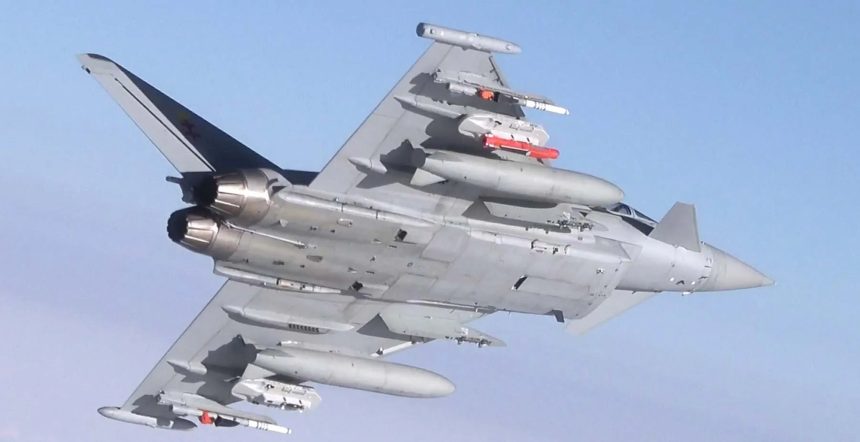A Typhoon operated jointly by BAE Systems and the RAF’s 41 Test and Evaluation squadron has successfully demonstrated the future of the Royal Air Force’s and Royal Navy’s F-35B weapons capabilities.
The RAF and Royal Navy’s latest cruise missile has been successfully test fired at the Vidsel range in Sweden, demonstrating the future of the F-35B’s weapons capability. A singular MBDA-developed SPEAR 3 missile was launched from a 41 squadron Typhoon, before it autonomously navigated to a target area containing a target main battle tank. SPEAR 3 then used its advanced all-weather radar seeker to map the target area, and used its radiofrequency imagery to successfully engage the target.
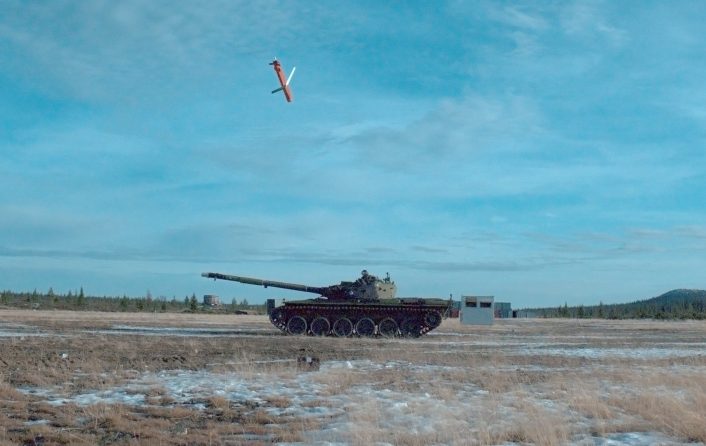
The test was conducted with a telemetry unit onboard the missile taking the place of live explosives. This allowed the RAF to monitor and record data on the missile’s release and long-range free-flight controls following a high-altitude and high-speed release which will be important data for further development of the weapon system.
A prototype of SPEAR had been test fired before in 2016, being launched directly from a Typhoon’s Pylon, where it performed as an initial capability demonstrator. Whereas, this latest test demonstrated the end-to-end function of SPEAR, running through its launch, its transition over to free flight, its carrying out of preprogrammed manoeuvres and then its engagement of the target.
Successful first guided firing of the new SPEAR mini-cruise missile!
SPEAR is a unique weapon system – the first to offer the range, flexibility, precision and load-out against modern enemy air defences.
Thanks to the teamwork of @DefenceHQ, @DefenceES, @BAESystemsAir and MBDA👏 pic.twitter.com/sC83k0oP7V
— MBDA UK (@MBDA_UK) November 18, 2024
Luke Pollard, Minister for the Armed Forces, stated that “The successful trial of the pioneering SPEAR missile marks a significant leap forward in UK Armed Forces’ capabilities, ensuring our Royal Navy and Royal Air Force personnel are equipped with cutting-edge technology to protect our nation.”
Dean Pask, the Ministry of Defence’s Senior Responsible Owner for SPEAR said that “This guided firing represents a major step in the capability development of the SPEAR programme and is the first in a campaign of firings to demonstrate the missile’s capabilities. The success of this test is a testament to the hard work and collaborative efforts of our industry partners at MBDA and BAE Systems, as well as MOD personnel across multiple teams. We look forward to continuing this momentum as we advance our domestic capabilities and strengthen our commitments to our allies.”
Watch the successful first guided firing of the new air-to-surface SPEAR 3 mini-cruise missile via @MBDAGroup. The missile is an air-launched cruise missile which measures only 2m in length and 0.180m in diametre but has an estimated range between 120-140km. pic.twitter.com/9ioAXWmwIu
— UK Defence Journal (@UKDefJournal) November 17, 2024
SPEAR 3
SPEAR 3 represents the future of the RAF’s combat air capabilities. Designed to equip the F-35B Lightning II, the SPEAR will allow it to strike at targets from a considerably longer range than it is currently able.
SPEAR stands for the Selective Precision Effects At Range project which was set up to produce the RAF’s next generation of air launched weapon systems. SPEAR 1 was the RAF’s Paveway IV precision guided bomb that has been deployed operationally since 2008 from Harrier, Tornado, Typhoon and now Lightning fast jets. Paveway IV consists of a 500lb bomb equipped with a dual mode GPS/INS and laser guidance kit, that is currently the only serviceable air to ground munition that the RAF and Royal Navy can deploy from the Lightning.
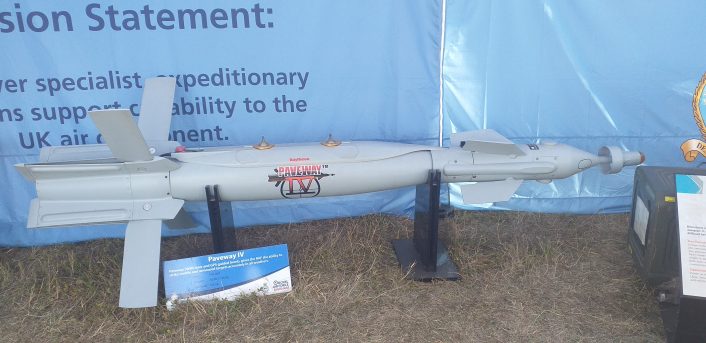
SPEAR 2 was the initial designation for Brimstone 2, the RAF’s premier supersonic, 60km ranged, anti-armour missile. This weapon system features a dual mode of use, either relying on laser guidance for controlled precision attacks or its onboard millimetric wave radar system that allows the missile to be used in a fire and forget manner. Designed mainly for destroying tanks Brimstone uses a tandem shaped warhead to penetrate the top armour of an armoured vehicle allowing a small payload of 14lbs to destroy the vehicle from the inside, lowering collateral damage. This was demonstrated at its best during Operation Ellamy, the UK’s response to the Libyan Civil War, where Brimstone was able to hit Libyan armour amidst crowded streets, with a lower risk of civilian casualties.
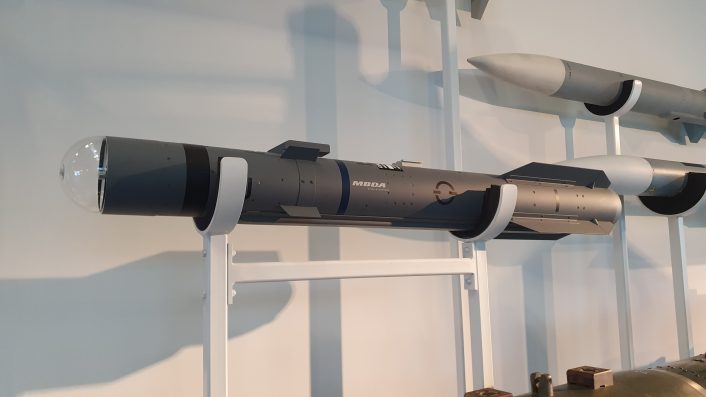
SPEAR 3 is intended to broaden the striking range of the RAF without resorting to the larger Stormshadow cruise missile. It is a subsonic missile, resembling Brimstone, but carries a foldable wing that extends the missile’s range to around 130km. It carries a sophisticated guidance system that uses its own inertial and GPS systems for initial navigation before the onboard millimetric wave radar, infrared or semi-active laser seekers home in on and destroy the target.
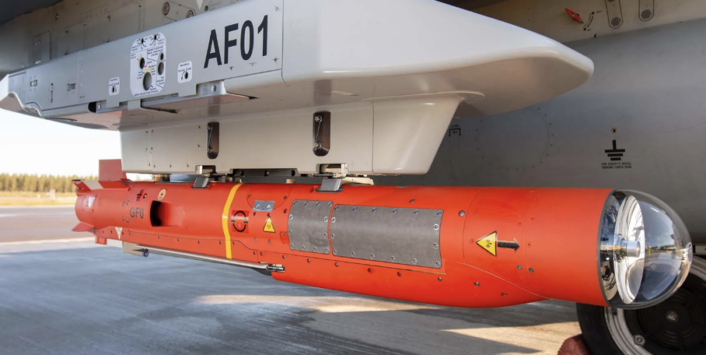
Designed primarily for the F-35B lightning II, SPEAR 3 will complement Paveway IV and allow the aircraft to strike at naval and land targets from a far larger distance. The warhead on board is only around 6-10kgs, but this is an advantage rather than a problem. The small size and large reach allows the Lightning to carry 8 missiles internally, granting it the ability to swarm targets with multiple missiles that overwhelm close in defences and strike at weak points on warships, and Surface to Air Missile (SAM) sites.
SPEAR is a next generation cruise missile and can hit targets from 100km away. It’s designed to be used against a range of targets, including air defences, ships, tanks, defended structures and fast-moving vehicles.
Footage of the successful test firing provided by @MBDAGroup pic.twitter.com/7cU2dJAnxw
— Ministry of Defence 🇬🇧 (@DefenceHQ) November 17, 2024
The primary role for SPEAR differs between the RAF and the Royal Navy. For the former it allows the performance of Suppression of Enemy Air Defence (SEAD) and Destruction of Enemy Air Defence (DEAD) mission sets, where the F-35 will be able to locate and track SAMs, avoid their radars and launch SPEAR to destroy the nodes that make up a SAM network, these being radar stations and missile launch platforms. For the Royal Navy SPEAR will be its primary long range strike missile. F-35Bs flown from HMS Queen Elizabeth or HMS Prince of Wales will infiltrate the airspace around enemy surface combatants, where they will launch SPEAR to destroy key pieces of equipment on board, rendering a mission kill rather than sinking the vessel. The Ministry of Defence here is choosing a single weapon system to fulfil two different mission sets that rely on accuracy, range and a mass of fire to effectively achieve success.
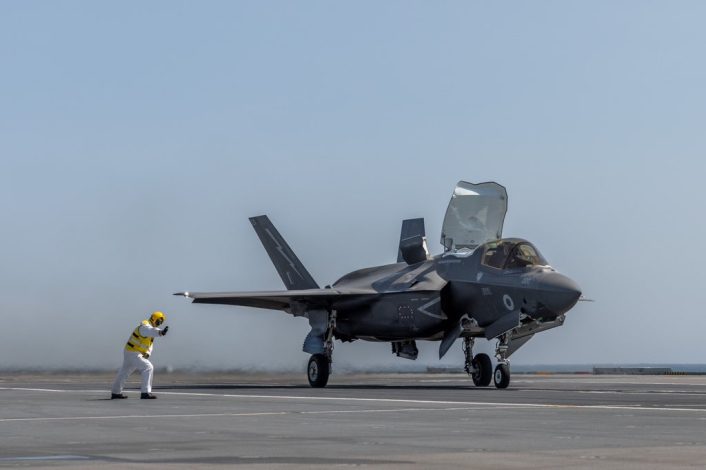
SPEAR EW
In order to achieve the above mission sets with SPEAR 3 an alternative version named SPEAR-EW is being explored to enhance the survivability of the strike package. This variant replaces the warhead with Leonardo’s miniaturised Digital Radio Frequency Memory (DRFM) technology, a highly advanced electronic jamming and deception system. This aims to deceive radars and present alternative targets to the actual strike package, allowing SPEAR 3 missiles to slip through and strike the target without being engaged.
The EW variant has been depicted with the concept for the new Typhoon ECR variant that the German Air Force are in the midst of developing. The Luftwaffe currently operates Brimstone missiles from their Typhoon force and a future buy of SPEAR EW and SPEAR 3 may be in the future if development remains successful.
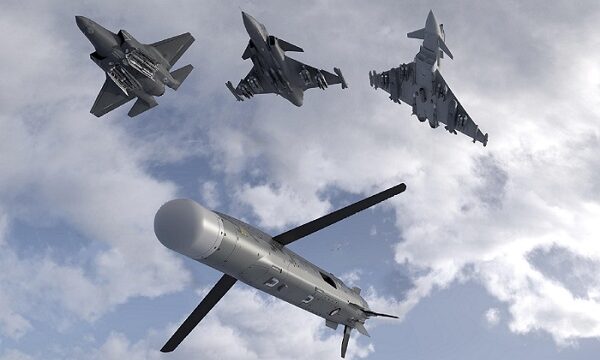
SPEAR EW is still in the development stage and will not enter into service with SPEAR 3, as there are still ongoing discussions surrounding what SPEAR EW aims to achieve. In the future this could include its own strike capability, hitting radar stations in lieu of SPEAR 3, however this is still in development by MBDA and Leonardo.
SPEAR is a cutting-edge cruise missile which will benefit RAF and @RoyalNavy F-35 Lightning pilots. It has had its first successful guided firing trial in Sweden.
Full story: https://t.co/tg2FUnowds pic.twitter.com/OreV9ibHZv
— Royal Air Force (@RoyalAirForce) November 17, 2024
Currently SPEAR is due to enter service in 2028 under its initial operational capability (IOC) but this represents a significant slip from the original date of 2025. Issues with the Block 4 upgrade to the F-35 have delayed the initial integration of SPEAR 3 and the UK’s advanced long range air to air missile the Meteor. As a result the UK’s F-35B’s are operating without the weapon systems they were intended to use. This forces a reliance on the older Paveway IV and AMRAAM missiles which do not complement the intended use of this F-35B fleet.
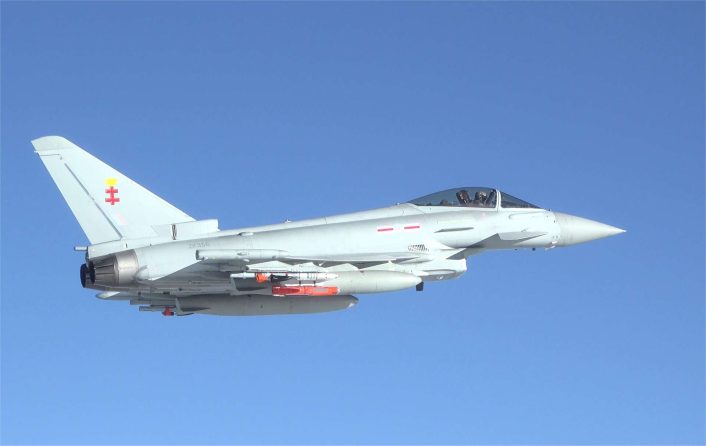
It is hoped that this test will bring the development of SPEAR forwards, allowing the RAF and Royal Navy to operate at the tip of the spear when it comes to weapons technology.

